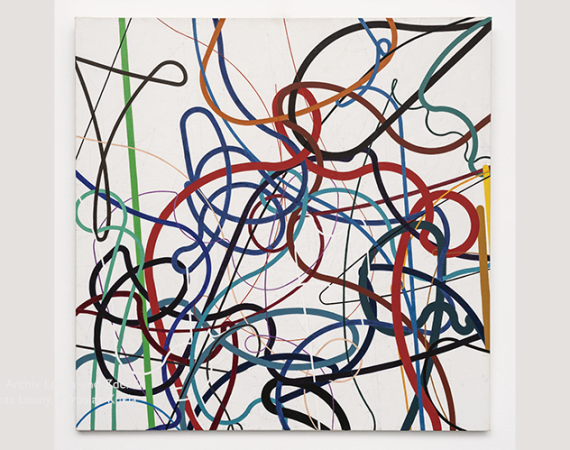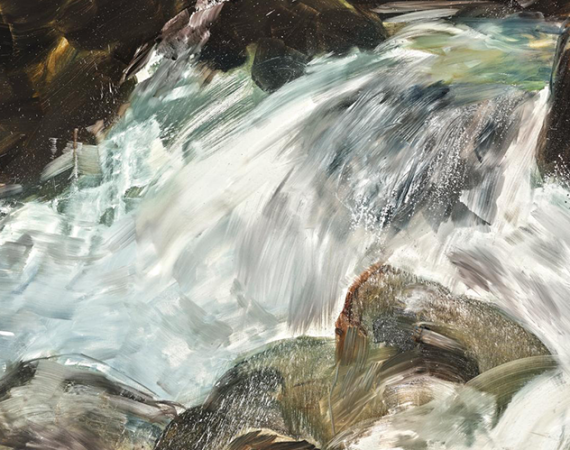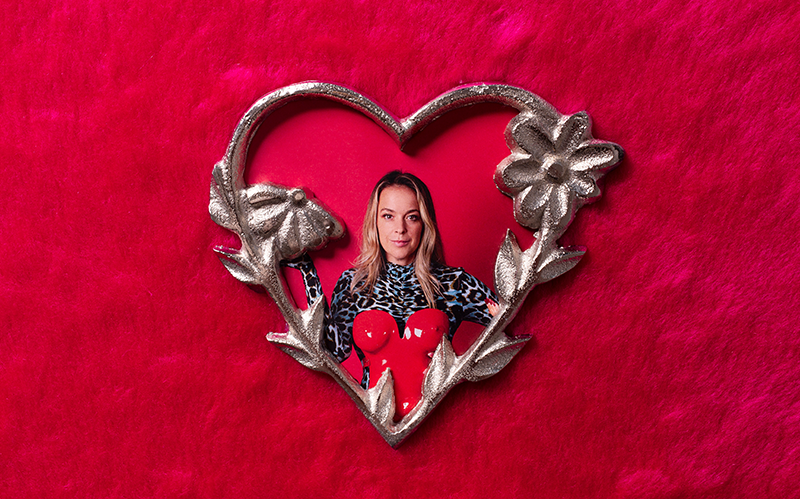
Vinyl, fetish gear, teddy bears and kitsch: Berlin-based fashion designer Marina Hoermanseder, a self-proclaimed maximalist, is no stranger to the powerful pull of contrast – especially when it comes to collecting.
Text: Doris Krumpl | Photos and Collages: Klara Johanna Michel
Berlin, Skalitzer Strasse. Tucked behind a graffitied wooden door in a turn-of-the-century building on one of Kreuzberg’s main thoroughfares – amid corner shops, kebab stands and shisha bars – is a contemporary version of Pippi Longstocking’s villa. You wouldn’t know it from the outside, standing in the stairwell of the back building, in front of a plain door with “HOERMANSEDER” written on it in discreet lettering. But behind that door, wow – a colourful explosion of colour, fabrics, high-gloss leather and pastel-coloured plush teddy bears, with Hoermanseder’s “mh” logo glowing in neon. Studio workers, bent over nude-coloured fabrics, sit attaching tiny Swarovski crystals beneath “vases” and “torsos” – garment sculptures made of patent leather, some with Lego glued to them – that are hanging from the ceiling. Into this vibrant empire walks Marina, her dog Taco in tow. She’s wearing Hoermanseder: a short black balloon skirt paired with an asymmetric sleeveless top, with her signature design element – the buckle – prominently displayed on one of the straps.
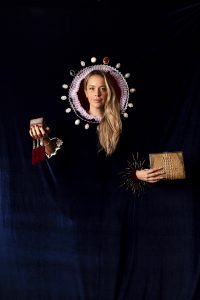
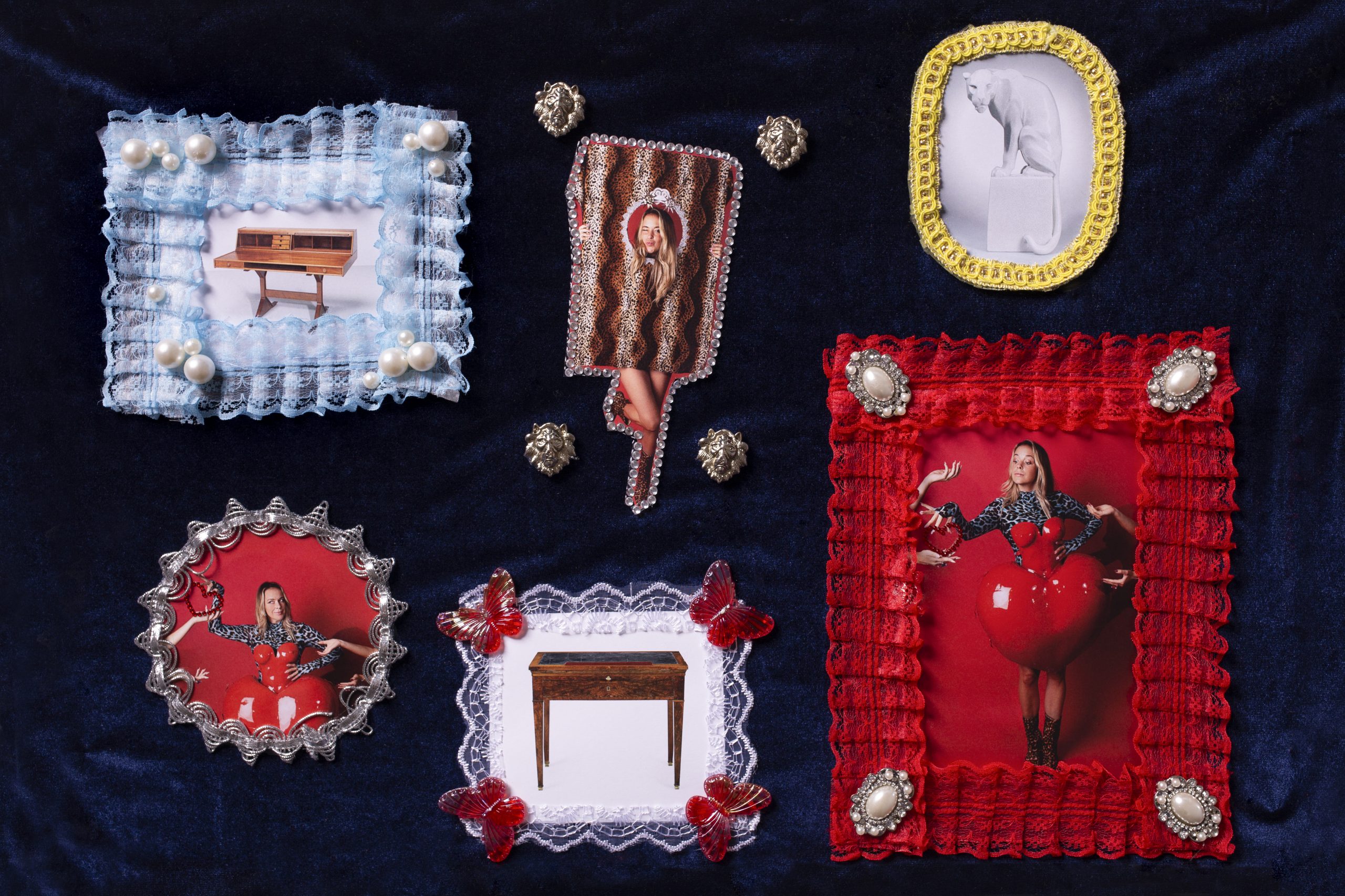
Dorotheum myARTMAGAZINE: When people hear Hoermanseder, they often think: “Oh, the one with the buckles!” But your fashion work is so much more than that one signature piece. Does it bother you that your work is often reduced to this one element?
Marina Hoermanseder: No, not at all. That’s been the case since my graduation collection, which was inspired by orthopaedics. The buckle is my absolute safety net, my lifeline – it takes away the fear of an empty page. I use it everywhere. I’ve never had to sit down and ask myself, “Where am I going to get my inspiration from now?” I’m also not someone who goes for walks for inspiration. I need objects!
And those are?
The human brain, orthopedic corsets, even the (19th century German children’s) book Max and Moritz. Every collection has specific objects that I incorporate as a reference. No matter what I draw from, I can pull it together – literally – with a buckle.

This hallmark aspect, your signature, has certainly opened doors for you, bringing in countless collaborations and licences. You’re really a master in that regard.
Karl Lagerfeld once said that a successful label needs two things: a good logo and a unique selling point. This means that a brand is successful when people recognise it instantly. I love seeing my designs on stars like Rihanna, but it’s also great that basically any woman on the street can wear products of mine, even for as little as two euros.
This last aspect has also attracted a certain amount of criticism …
Yes, the criticism that my approach isn’t “artistic” enough, so to speak. But at some point you have to decide whether you want to be an artist, tinkering away alone in your studio, or whether you want to build a business with employees and responsibilities. I do what I want to do, not what has to sell or please others. And I think that’s the stage every artist wants to get to, where they’re creating what they really want to create.
Was the brand name – a somewhat unwieldy one for some people, Americans for example – always the obvious choice?
In the beginning, everything happened so fast that I didn’t think about it much. For a while I regretted that the brand was so closely linked to my name and me as a person. I can never really present it as something completely independent.
With your massive online and social media presence, you’re essentially an influencer as well.
That was when I realised it was working. That’s when I knew the brand wasn’t faceless, it could be emotionally charged with a per- son behind it. That’s so important now; it wasn’t like that before. But now you have to give a brand a story and an emotional dimension. And the best way to do that for us humans is through a per- son, someone we can identify with and relate to.
You offer both ready-to-wear collections online and star-studded collections for the likes of Rihanna, Lady Gaga and FKA Twigs in your Los Angeles showroom.
When it comes to the latter collections, I’m a pure artist. In that case it’s not about selling, it’s about moments and creations. The clothes we sell as a label online are streetwear. They give me artistic freedom and independence.
Does the showroom also function as a shop?
Not really. It doesn’t make sense for the Marina Hoermanseder brand to have a physical store. What would we sell there? I don’t want to make blouses and trousers! I want showpieces, I want art, I want my orthopaedic leather, I want craftsmanship – all the things people don’t necessarily look for when they go into a shop. Some people really identify with and buy our strap skirts, and collectors or museums buy our leather vases, but it’s a niche.
These Vases – sculptural dresses – sit at the intersection of fashion, design and art. They could easily be displayed in a gallery.
That’s another thing I’d love to do one day: show in a gallery!
You also design a wide range of products, from watches to tissue box covers. What does good design mean to you?
It’s something that stays with you after you’ve seen it. Regardless of aesthetic judgement. Something that somehow sticks in your mind and evokes emotions.
You’re originally from Vienna, but you’ve lived in Berlin forquite some time. Would you say the city is a good fit for you?
I love Berlin. I moved here when I was 25 to study fashion and start my own business. When my flatmates came home from parties in the early hours of the morning, I’d still be working on my sketch portfolios for university. These days I live a bit outside the city, sur- rounded by greenery, with a garden, a vegetable patch and kids. It’s my own little world. But I still have Kreuzberg. From the beginning I appreciated that nothing is off-limits in Berlin. There’s no judge- ment, and that’s something Vienna hasn’t quite got the hang of yet.
Does the freedom you mention extend to your fashion as well?
If I had started with this style in Vienna, I don’t think I would have been as successful. “Orthopaedics and skin diseases – do you really need to go there?” In Berlin, you should go there.
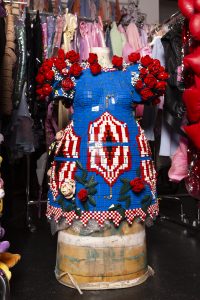
You combine a lot of contrasting elements even in terms of your interiors and the way you live – mixing high and low, soft and hard, comics, manga and art. Would you say you’re a maximalist?
I’m the biggest maximalist there is because I have so many things that I love. I don’t throw anything away.
So, you’re the ultimate collector?
It’s just … a lot. I’m with someone who wants to see the remotes neatly lined up on an empty coffee table. But I’ve taught him my way: not to have less, but to make room for more! So many things can trigger emotions in me. I feel comfortable when there’s a lot of stuff around. Maybe it goes back to my childhood. In my parents’ kitchen, the toaster was always put away in a drawer after break- fast. The kitchen was empty.
Like in an ad?
Absolutely empty. Even as a child I was the opposite. This maxi- malist aspect is also what defines my collections. I took it to the extreme in January this year with my first post-COVID show: so much decoration, no look to serve as a kind of breather for the audience. That’s why I went with the circus theme and the “more is more” mantra. It was everything that had been pent-up from when we couldn’t do anything at all.
Among those pieces were Vase Dresses – sculptural construc- tions essentially made of orthopaedic corsets in lacquered leather, reminiscent of ancient idols and hypertrophic fertili- ty symbols. There was also your extraordinary flesh-coloured dress called Venus, with its voluptuous curves à la Venus of Willendorf.
That piece struck a special chord. The audience was in tears! We also played Unbreakable, of course, complete with glitter rain. That’s what I do – it’s all about emotion, about creating moments of magic. How many moments do we have that really stay with us?
Maybe in art or theatre. What do you enjoy doing?
I find wandering through flea markets or shopping at auctions much more rewarding and easier to deal with than visiting galleries. The atmosphere is different, I feel more free. I never know what I’m going to find or what I’m going to get. Maybe that goes back to the maximalism we were talking about. I’m also much more of an impulse buyer. I don’t care about the name of the artist so much – it’s about whether there’s a connection.
You bought a bodice, for example, that you keep in your stu- dio. What moved you to buy it?
When I was a student, I wanted to learn about corsets, so I bought a piece at Dorotheum to have a look at its construction and materi- als. That’s how I discovered orthopaedic corsets. It started with an illustration of an 18th or 19th century corset made of wood, metal and leather that I wanted to recreate. I got into bodices during my time with Alexander McQueen in London.
How did Dorotheum catch your interest?
Through my father. He loves Dorotheum and is constantly send- ing me objects that might inspire me, like two embroidered antique handbags from Papua New Guinea that look remarkably like the Chloé bags of today. They now hang in a Perspex box in my flat. I started buying after I’d purchased a home of my own.
Any examples?
I was looking for a Biedermeier chest of drawers. Dorotheum was, of course, the place to go. The piece is now in my Berlin apartment, surrounded by my gallery wall. I may be a designer in Berlin, but I’m still a bit of a Viennese traditionalist. The chest brings a touch of cosy Viennese comfort into my colourful designer home. What’s important to me, what I love, are contrasts – hard and soft. As in my collections, so in my home. I like hearts, but I also need some- thing angular and hard next to them.
Dynamic contrasts and clashes. And what is on your Bieder- meier chest of drawers?
A lovely yellow vase with black polka dots on it, which is kind of “chic”.
Marina Hoermanseder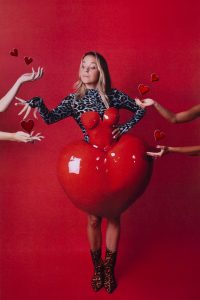
is a Berlin-based fashion designer with Austrian-French roots. After reading International Business in her hometown of Vienna, she went on to study at the ESMOD fashion school in Berlin, graduating in 2012. That same year, she completed a four-month internship with Alexander McQueen in London. In 2013, Hoermanseder launched her own fashion label, which debuted its first collection at Berlin Fashion Week in early 2014. The brand is known for its signature leather strap skirts, leather corsets and buckles. Her label, “Marina Hoermanseder”, is popular with celebrity stylists, including those for stars such as Rihanna, and includes both an artistic line with a showroom in Los Angeles and “HOERMANSEDER” branded streetwear available online. The designer, a recipient of numerous fashion awards, has also been a judge on Germany’s Next Topmodel twice, most recently in 2024. Over the years she has collaborated with various companies and brands including Palmers, RADO, Deutsche Telekom, Österreichische Post, Hello Kitty and Care Bears. Marina Hoermanseder, 38, lives with her family in Berlin.









